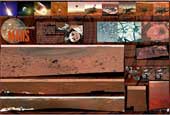
 |
|
|
|
Presenting the story of pulsars might have been a difficult task in view of its history, which in astronomical terms is relatively short, being contained entirely within the period from 1967 to the present day. It is also a very human story in spite of being rather specialised from an astronomical point of view. The author begins with some background information on the life and death of stars, an introduction to the neutron that is essential, some comments on quasars and a few words about Tony Hewish and Jocelyn Bell to set the scene. The manner in which the two worked together is treated sensitively as indeed it should be, they having brought back radio astronomy to the public attention by their discovery of the radio pulsar. After the announcement of the discovery it was inevitable that a search would be made for an optical version of the same phenomenon and three young men, a Briton, Mike Disney, and two Americans, John Cocke and Don Taylor made the important discovery using, it is said, borrowed equipment. Not surprisingly the number of teams involved in the search for more and different pulsars grew quite quickly. The personnel changed, but the excitement continued and success brought more success, a situation that the author has captured and sustained throughout the book. Being Australian he has also included the efforts of the Australian radio astronomers, which were extremely successful. There are now a number of different types of pulsar, some having been found in the most unlikely places, for instance globular pulsars, pulsars with planets, magnetars and multibeams. The presentation is never boring and manages to convey the continued excitement that identifies the subject. I can only recommend it. Bill Barlow |
|
|
|
2009 Yearbook This 132-page special edition features the ultimate observing guide for 2009, a review of all the biggest news stories of 2008, in depth articles covering all aspects of astronomy and space missions for 2009, previews of International Year of Astronomy events and much, much more. This 132-page special edition features the ultimate observing guide for 2009, a review of all the biggest news stories of 2008, in depth articles covering all aspects of astronomy and space missions for 2009, previews of International Year of Astronomy events and much, much more.Infinity Rising  This special publication features the photography of British astro-imager Nik Szymanek and covers a range of photographic methods from basic to advanced. Beautiful pictures of the night sky can be obtained with a simple camera and tripod before tackling more difficult projects, such as guided astrophotography through the telescope and CCD imaging. This special publication features the photography of British astro-imager Nik Szymanek and covers a range of photographic methods from basic to advanced. Beautiful pictures of the night sky can be obtained with a simple camera and tripod before tackling more difficult projects, such as guided astrophotography through the telescope and CCD imaging.Exploring Mars  Astronomy Now is pleased to announce the publication of Exploring Mars. The very best images of Mars taken by orbiting spacecraft and NASA's Spirit and Opportunity rovers fill up the 98 glossy pages of this special edition! Astronomy Now is pleased to announce the publication of Exploring Mars. The very best images of Mars taken by orbiting spacecraft and NASA's Spirit and Opportunity rovers fill up the 98 glossy pages of this special edition!Mars rover poster  This new poster features some of the best pictures from NASA's amazing Mars Exploration Rovers Spirit and Opportunity. This new poster features some of the best pictures from NASA's amazing Mars Exploration Rovers Spirit and Opportunity. |
||||||||||||||||||||||||